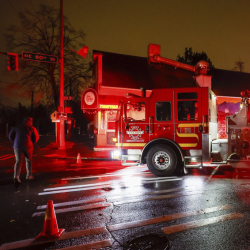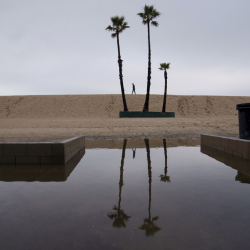 A Florida judge put the fate of George Zimmerman into the hands of a six-woman jury Friday, setting the stage for what could be the final chapter in a legal saga that began with Trayvon Martin's death and highlighted sharp divisions over race and gun control in the United States.
A Florida judge put the fate of George Zimmerman into the hands of a six-woman jury Friday, setting the stage for what could be the final chapter in a legal saga that began with Trayvon Martin's death and highlighted sharp divisions over race and gun control in the United States.
The jury began deliberations moments after Judge Debra Nelson finished reading instructions about the laws they must consider.
"It is up to you decide which evidence is reliable," Nelson told the jurors. "You should use your common sense."
She told the jury that Zimmerman exercised his legal right not to testify, and they cannot "view this as an admission of guilt."
"It is not necessary for George Zimmerman to prove anything," Nelson said.
Police in Seminole County and elsewhere steeled for the possibility of violent reactions to the verdict, while the Rev. Jesse Jackson Jr. called for a calm response to the jury's decision, no matter what it is.
"If Zimmerman is convicted there should not be inappropriate celebrations, because a young man lost his life, and if he is not convicted we should avoid violence because it will only lead to more tragedies," Jackson said.
Zimmerman, 29, is accused of second-degree murder for killing the 17-year-old Miami teenager on February 26, 2012, in a Sanford, Florida, neighborhood. He has always acknowledged killing Martin. The question has been why.
Race is one of the many issues that has permeated the trial. Critics have said race played a role in Zimmerman's actions. He is Hispanic; Martin was African-American.
In their arguments, prosecutors described Zimmerman a frustrated wannabe police officer who took the law into his own hands -- deciding Martin was one of the criminals who had been victimizing his neighborhood, then trailing him against the advice of police dispatchers, and wrongly shooting him to death.
"The defendant didn't shoot Trayvon Martin because he had to," Assistant State's Attorney John Guy told jurors in a rebuttal argument that followed defense lawyer Mark O'Mara's closing argument. "He shot him because he wanted to. That's the bottom line."
Guy argued Zimmerman built a tissue of lies to conceal vengeful frustration and powerful determination not to allow someone he had already decided was a criminal to escape.
And he said Zimmerman's under-his-breath commentary, captured on a police recording, about "f***ing punks" -- apparently directed at Martin -- revealed Zimmerman's hatred and ill-will toward the teenager.
That's important because under Florida law, a conviction on second-degree murder requires jurors to find that Zimmerman shot Martin out of "ill will, hatred, spite, or an evil intent."
Guy said Zimmerman's language does just that.
"Common sense tells you it's the person talking like the defendant who had hate in his heart," Guy said.
"What is that when a grown man, frustrated, angry, with hate in his heart, gets out of his car with a loaded gun and follows a child? A stranger? In the dark? And shoots him through him heart?" Guy said. "What is that?"
It was, defense attorney Mark O'Mara argued, nothing more than self-defense.
Defense argument
"How many 'coulda beens' have you heard from the state in this case," O'Mara asked. "How many 'what ifs' have you heard from the state in this case? They don't get to ask you that. No, no, no."
"Do not give anybody the benefit of the doubt except for George Zimmerman," O'Mara said.
O'Mara tried to discredit the prosecution's image of Zimmerman as a frustrated, spiteful vengeance-seeker, saying it was Martin who stalked Zimmerman and emerged from the darkness to pounce on Zimmerman, pinning him to the ground and slamming his head into the concrete sidewalk.
"That's cement; that is a sidewalk," O'Mara said, lugging a heavy block of cement to a spot on the floor in front of the jury. "And that is not an unarmed teenager with nothing but Skittles trying to get home. That was somebody who used the availability of dangerous items, from his fist to the concrete, to cause great bodily injury against George Zimmerman."
In his rebuttal, Guy ridiculed the argument that Zimmerman had suffered substantial injuries, saying repeated blows against concrete would have caused more damage than the rivulets of blood and bumps seen in photographs from the night of the shooting.
Judge Nelson ruled Thursday that jurors will be allowed to consider manslaughter in addition to the original second-degree murder charge.
The prosecution
In the prosecution's initial closing argument, delivered Thursday, prosecutor Bernie de la Rionda argued that Zimmerman's account that he fired his gun because he feared for his life does not hold up.
"He brought a gun to a struggle, to a fight that he started ... wanting to make sure the victim didn't get away," the prosecutor said. "And now he wants you to let him off because he killed the only eyewitness, the victim Trayvon Martin, who was being followed by this man."
Although Zimmerman did not testify before his defense team rested its case on Wednesday, his words were front-and-center a day earlier.
The prosecutor sought to pick apart interviews Zimmerman had given to police and in the media.
Why would a scared man get out of his car and walk around after being told by a 911 dispatcher not to follow the victim? Did Zimmerman walk toward Martin, or did Martin come after him -- he seemingly said both? Should he have had more than a bloody nose and scratches on his head if he'd had his head slammed on the ground by the victim?
"(Zimmerman) always has an excuse, or they catch him in a lie," de la Rionda said.
On the day the defense rested, O'Mara said Zimmerman was considering testifying.
"He really wanted to talk to his jury and tell them what he did, why he did it and what he was facing when he made that decision to fire the shot," O'Mara sid on CNN's "AC 360."
But there was no need for him to testify, he said, because the state had not proven its case beyond a reasonable doubt.
The trial kicked off June 24 with opening statements. The prosecution called 38 witnesses in nine days while the defense took parts of four days to call its witnesses.
After the verdict
Preparing for the possibility of violence in reaction to the verdict, the sheriff's office in Broward County, in the Miami area, said it had made a contingency plan to respond to incidents, and was spreading the word to remain calm through a public service announcement.
"Freedom of expression is a constitutional right," the sheriff's office said in its statement. "While raising your voice is encouraged, using your hands is not."
O'Mara said that, whatever the outcome, his client will not feel safe.
"There are a percentage of the population who are angry, they're upset, and they may well take it out on him," he said.
A nation, divided
The case has divided the nation on issues of race and gun laws.
After the shooting last year, police did not immediately charge Zimmerman, citing Florida's "stand-your-ground" law. The law allows those who believe they are in imminent danger to use deadly force to protect themselves.
Protesters took to city streets in support of the teen's family. Some wore hoodies, as did Martin the night he was killed.
In April last year, the Florida state prosecutor stepped in and charged Zimmerman.
Supporters have maintained that the teen was a victim of racial profiling, tailed by the defendant over the objection of police dispatchers, then wrongly shot.
Mother vs. mother
In testimony, the mother of the victim and the mother of the defendant identified an anguished voice on a 911 tape as having come from their respective sons. On the night of the killing, as residents made 911 calls to report the altercation, yells for help can be heard in the background.
Various neighbors called 911 and described what they saw and heard. But none of them saw the entire altercation, according to testimony.
Some described hearing a gunshot.
The prosecution has said the absence of Martin's DNA on the pistol Zimmerman was carrying disproves defense arguments that the teen grabbed the gun during the struggle.
Foam dummy, mystery
The deliberations cap a week of drama that included both sides using a foam dummy to describe the struggle.
Each side has used unusual means in an effort to prove its case.
Thursday's closing argument marked the return of the dummy that had appeared a day earlier when O'Mara used it to show jurors the competing theories of what happened the night Martin died.
This time it was de la Rionda's turn to characterize Zimmerman's account. He said the teen punched him, slammed his head and covered his neck and mouth.
The prosecutor questioned how Martin -- while he was allegedly punching Zimmerman, slamming his head onto the pavement and covering his neck and mouth -- could have also reached for the gun that Zimmerman said was in a holster inside his waistband, as the defense suggested.
HLN's Grace Wong, Graham Winch, Amanda Sloane, Jonathan Anker and Anna Lanfreschi and CNN's John Couwels and Mayra Cuevas contributed to this report.
Portland and Seattle
Free Subscription to Breaking News
Free Subscription to Breaking News




















































































































































































































































































































































